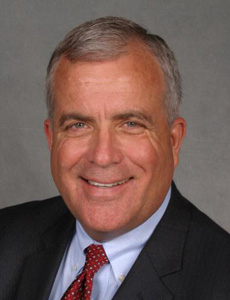2016 NWCDC Keynote Preview
Disney’s Tim East Tapped for NWCDC Keynote

When your brand is synonymous with happiness, there’s a lot riding on making everything look effortless — no easy feat when you’re managing risk. Tim East knows that better than most — he’s been doing it for decades.
Burbank, Calif.-based East, one of the risk management directors for The Walt Disney Company, is positioning his company to keep pace with a world that’s moving faster than a ride on Space Mountain.
That is why the advisory board of the 25th annual National Workers’ Compensation and Disability Conference® & Expo selected East to deliver the opening keynote presentation at this year’s event, scheduled for Nov. 30-Dec. 2 at the Ernest N. Morial Convention Center in New Orleans.
From the Ground Up
East currently oversees risk financing, construction insurance programs, risk management government affairs, and risk management for the company’s international theme parks.
But he got his start in 1974, in the administrative services area.
“I was in the janitorial department at Disneyland. That’s where I started,” he said. By 1982, he was Supervisor of Safety, involved with “training and preparing the policies and procedures and training the executives of the park’s operations.” He was also involved with training and supporting the opening of Tokyo Disneyland.
From there, East served in a variety of risk management positions at The Disneyland Resort in Anaheim. From his role in safety, he went on to head the workers’ compensation claims department and implemented the first Limited Work Program at Disneyland. He assumed his current role in January 1996.
Outside his company role, East is the chair of the California Self-Insurers Security Fund, a past chair of the California Coalition on Workers’ Compensation, and a trustee of the California Self Insurers Trust Fund. He regularly meets with lawmakers, policy advisors, trade organizations, and the California governor’s office on insurance and workers’ comp issues.
East’s resume boasts an impressive list of degrees and certifications. He was named the Insurance Institute of America’s Distinguished Graduate in 1995. That same year, he also received the Christy Award from the Risk and Insurance Management Society for having the highest composite score of 1,400 associate risk management candidates.
Change With the Times
If, like East, you were in the industry in the ’80s, you may recall it was common to see mail clerks walking through claims offices pushing carts loaded with files for claims examiners. When a claim went before an appeals board, it was typical to see attorneys and others on both sides carrying 10-inch files.
The move to a paperless system was a sea change in that era. East believes the time has come for another profound shift in the way the workers’ comp system conducts business.
In his keynote address, East will explore strategies for leveraging rapidly changing technology to engage injured workers and facilitate recovery.
“We have to make another transformation in our use of technology, and we’ve got to link technology and social media change so we bring the two together in a way that makes us more effective in our roles,” East said.
Communicating with injured workers is a key piece of managing claims, and East says that’s one area where the power of technology can effectively be harnessed.
“Twenty or 30 years ago we would send a ‘hello’ letter [to the injured worker]; a two- to three-page letter with everything they needed to know. It was very personal,” he said. “Nobody reads a two-page letter. That is so counterproductive today. It’s like horse and buggies at an Indy 500.”
Instead, East said, many people, especially younger workers, use electronic forms of communication. The industry needs to take notice.
“The injured worker of today, the next generation, wants shorter communication from employers. Brief bits of information that help them, and that they find useful and relevant,” East said. “Young people want to know, ‘How is this going to help me?’ We’ve got to find a way to communicate.”
The same applies to physicians’ offices and supervisors. Snail mail, he says, “is not necessarily the way they want to be communicated with. We have to change that.”
As businesses are increasingly driven by attaining better outcomes, East says many are starting to come around to the idea of providing shorter, more frequent, succinct information to their employees and others involved in the workers’ comp system.
“Young people want to know, ‘How is this going to help me?’ We’ve got to find a way to communicate.” — Tim East, director of risk management, The Walt Disney Company
“It is finding new platforms, new ways of communicating,” he says, “be it text, Twitter, and social networks to actually parse information down to small little packets to injured workers who don’t want a letter, form, or phone call. Letters, forms, and phone calls were the biggest tools in the toolbox once. They are bygones.”
The same changes need to occur throughout the industry’s efforts to attract and retain talent, East said. Outdated modes of communication are hampering recruitment efforts.
“Young people are looking for relevancy in their roles,” he said. “I don’t think there is anything more relevant than helping people maintain their jobs and health. We have the relevancy, but we are not communicating it. I don’t think we help people feel the relevancy and see how important their roles are.”
East also says it’s time for a move away from what he calls the focus on big massive claims administrative systems.
“It’s a necessary infrastructure, but it needs to change in two directions — toward the injured worker and the employer,” he says. “The first is leveraging these massive claims administration systems and data systems to provide better analytics, better information that [employers] can make decisions more accurately, more timely, and formatted so employers can grasp the message.”
That involves extracting information from the huge amounts of robust data. Additionally, there’s a need to link the systems to better focus on the injured worker and manage the process more effectively.
To hear more of East’s thoughts on the future of employee engagement, join your fellow industry professionals at NWCDC this fall.











